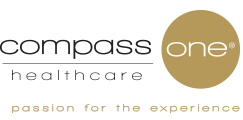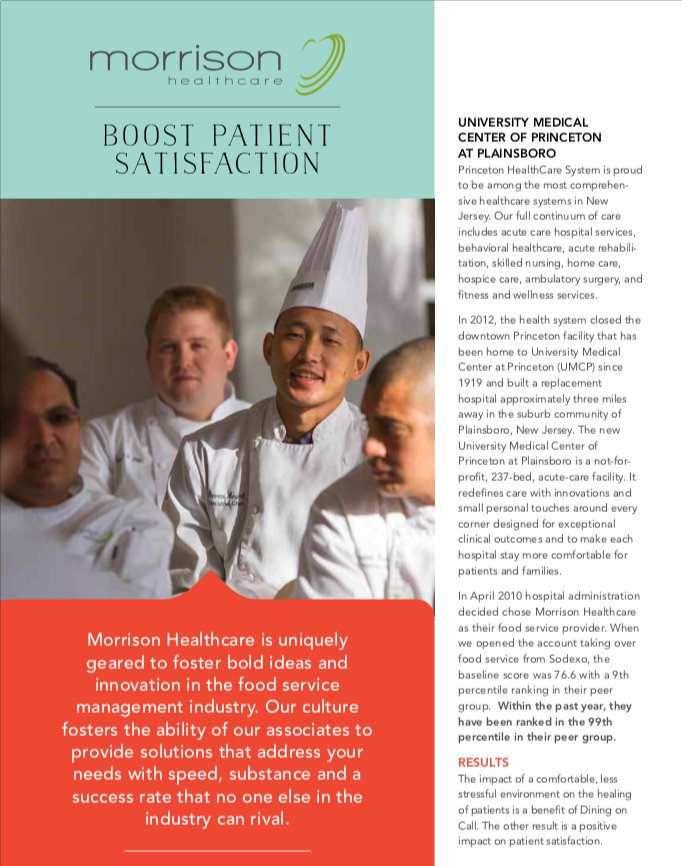
University Medical Center of Princeton at Plainsboro
Morrison Healthcare is uniquely geared to foster bold ideas and innovation in the food service management industry. Our culture fosters the ability of our associates to provide solutions that address your needs with speed, substance and a success rate that no one else in the industry can rival.
University Medical Center of Princeton at Plainsboro
Princeton HealthCare System is proud to be among the most comprehensive healthcare systems in New Jersey. Our full continuum of care includes acute care hospital services, behavioral healthcare, acute rehabilitation, skilled nursing, home care, hospice care, ambulatory surgery, and fitness and wellness services.
In 2012, the health system closed the downtown Princeton facility that has been home to University Medical Center at Princeton (UMCP) since 1919 and built a replacement hospital approximately three miles away in the suburb community of Plainsboro, New Jersey. The new University Medical Center of Princeton at Plainsboro is a not-forprofit, 237-bed, acute-care facility. It redefines care with innovations and small personal touches around every corner designed for exceptional clinical outcomes and to make each hospital stay more comfortable for patients and families.
In April 2010 hospital administration decided chose Morrison Healthcare as their food service provider. When we opened the account taking over food service from Sodexo, the baseline score was 76.6 with a 9th percentile ranking in their peer group. Within the past year, they have been ranked in the 99th percentile in their peer group.
Results
The impact of a comfortable, less stressful environment on the healing of patients is a benefit of Dining on Call. The other result is a positive impact on patient satisfaction.
At the beginning of the initiative, Food and Nutrition Services had a Press Ganey mean score of 77.5. After initiatives were implemented, Princeton at Plainsboro food services had a patient satisfaction mean score of 85.1 and ranked in the 99th percentile of all Press Ganey hospital clients in New Jersey.
In addition to improving patient satisfaction scores by nearly 8 points, less food was wasted when patients were unable to eat during hospitalspecified food delivery times due to illness or being away from their rooms for testing. It also saved time spent by the nursing staff working to meet the needs of hungry patients outside of hospital-specified meal delivery times.
Employee satisfaction was achieved as well. While change is always difficult to manage and implement, employee indifference became employee happiness as satisfied customers shared appreciation versus creating stress. Dining on Call and the new way of doing things increased staff ownership and work satisfaction.
How success was achieved
Challenges were identified. Focus groups with nurses and patients uncovered opportunities for improvement. Additional focus groups were conducted to discuss solutions to our challenges. Challenges included:
- Accepting and embracing change by food services staff as well as ensuring support from nursing staff.
- Learning a new system while still using an old one.
- Training nutrition operators to be the new first point of contact for the guest.
Collaboration between food services and the nursing staff was key to serving the delicate nutrition needs of people with Diabetes and to notifying food services of new admits so they could be visited and told of Dining on Call as soon as possible. Increases in patient satisfaction scores are attributed to:
- In-services designed to train new work flows created by implementation of Dining on Call and working in a new hospital.
- The menu was updated and re-organized to meet the requests of the diverse needs of patients. Creating a vegetarian section in the menu is one example of a satisfier.
- A Press Ganey Wall of Fame created in Food and Nutrition Services to publicize positive comments, percentile rankings as well as individual and group efforts to improve satisfaction. The board was sprinkled with staff pictures to create intrigue, ownership, and increase staff morale. Each quarter one overachieving employee was rewarded with “Brad Bucks” from the department director, interviewed and, again, recognized on the Wall of Fame. Those providing great service could also be recognized through the medical center’s “Star” program.
- Managers’ expectations of zero variation in use of scripting and adhering to policies.
- The importance of teamwork was demonstrated from the top down.


